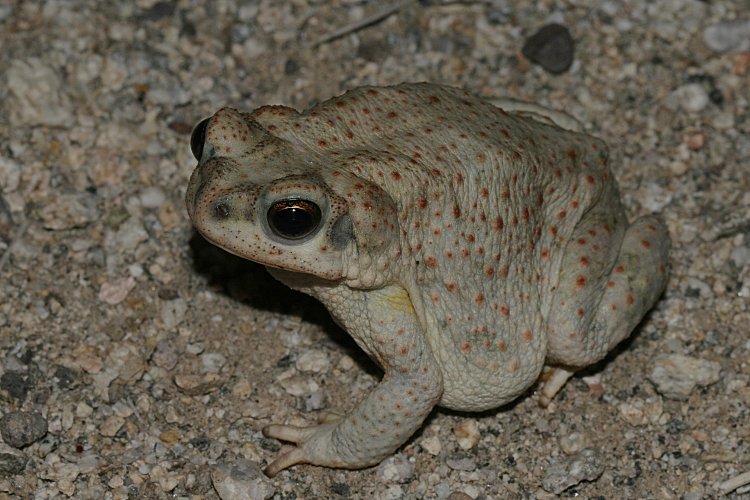
Red-spotted Toad.
The first night we road cruised in the Tucson area. The first herp we saw
was a Sonoran Desert Toad. For reasons I don't recall we opted not
to photograph it, perhaps because we had not yet reached our destination
and were eager to get there.
We wound up seeing very little during our subsequent roadcruising;
the only other herp we saw that night
was this:

Red-spotted Toad.
We woke up early the next morning and headed out. We would spend the remainder of the trip in and around the mountains south and/or east of Tucson. The first day we met up with Young Cage who lives near Tucson.
The first reptile of the trip was found under a rock:
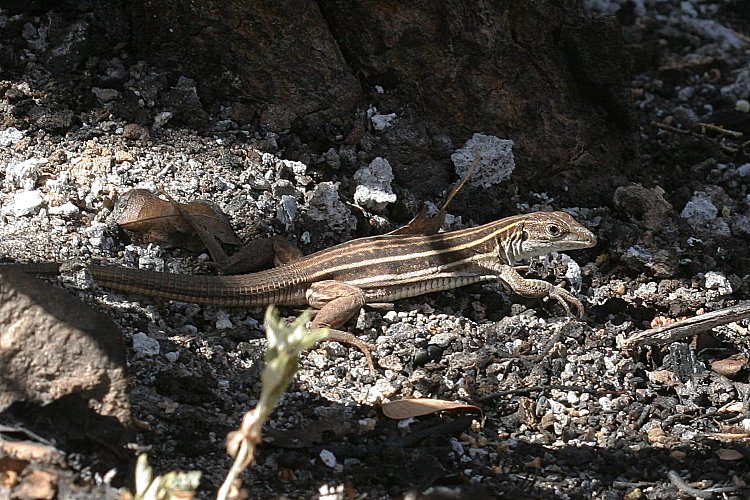
Sonoran Spotted Whiptail (Aspidoscelis sonorae).
It was around 3 inches SVL. I'm pretty sure it's not an
Aspidoscelis burti, which looks similar but grows much larger.
Here's another look at the same animal:
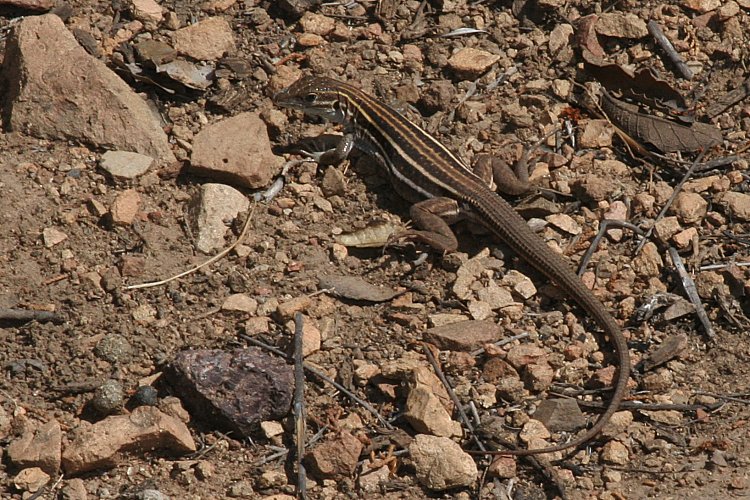
It is worth noting that this was the
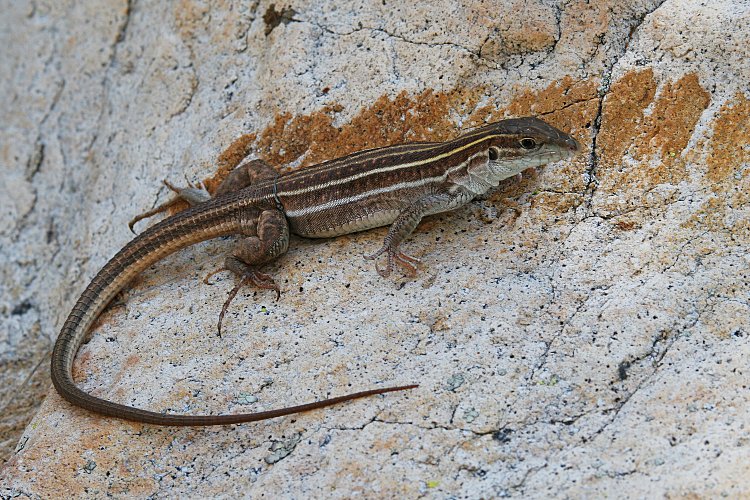
If you look carefully you can see the noose. Closer:
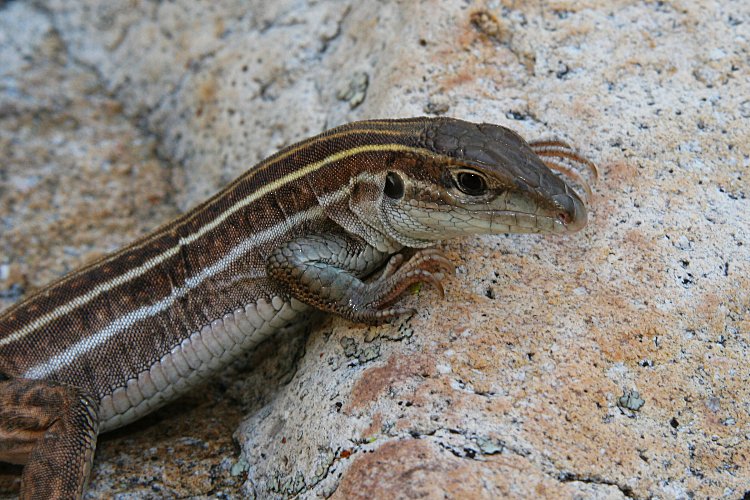
This one appeared to be gravid.
We decided to try another spot farther up the canyon. Along the drive,
Young spotted this beautiful cactus from the vehicle:
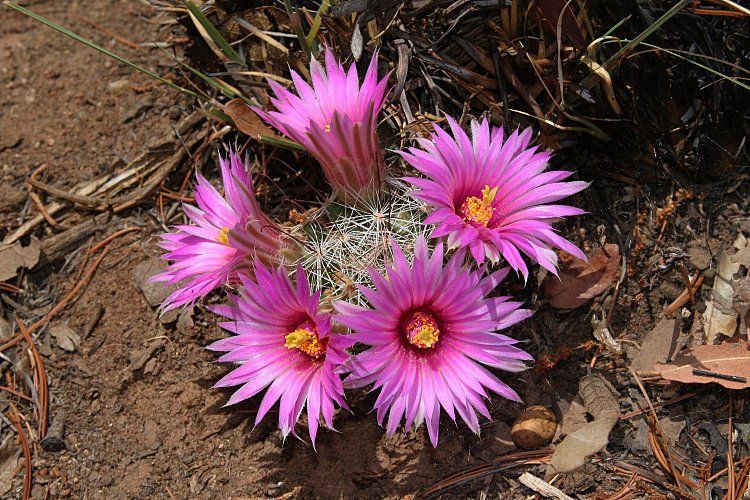
Arizona Fishhook Cactus (Mammillaria microcarpa).
This plant really stood out as the surrounding area was very dry.
We parked and headed out again. Soon after we started, the skies clouded up and we were treated to a rain shower. The shade and drop in temperature was most welcome. We also hoped that it would increase our chances of encountering a snake or two out on the crawl.
First off we saw this Tree Lizard:
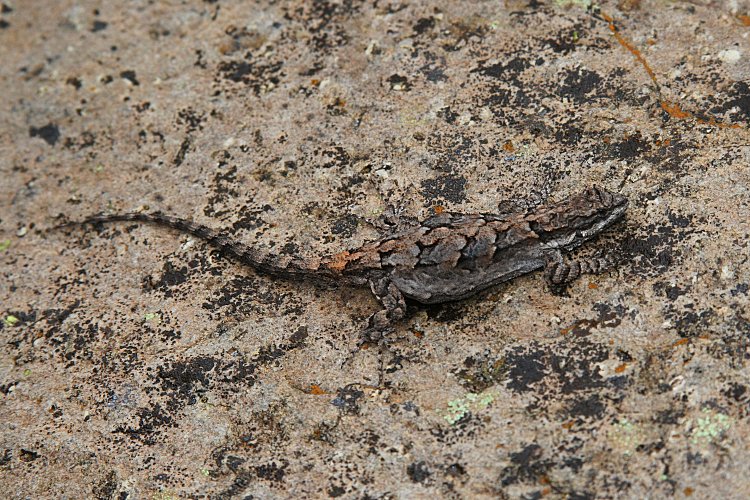
It blended in very well with its rock. Another look:
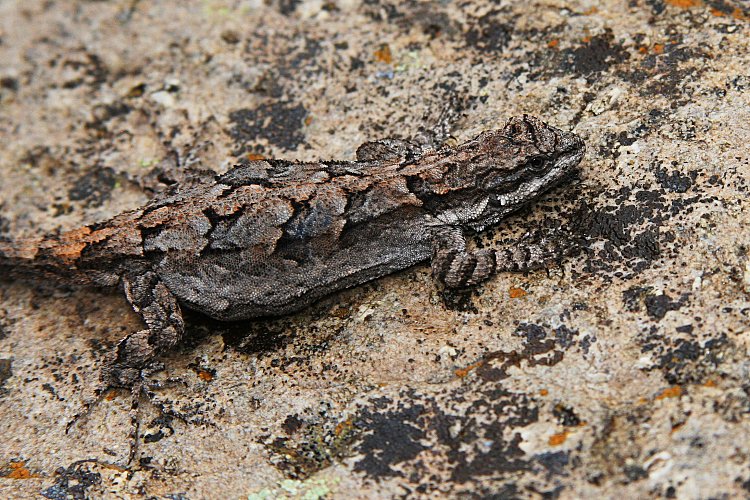
It too looked to be gravid.
A little while later we heard Jason yelling about something
from a little side canyon he was exploring. Look what he found:
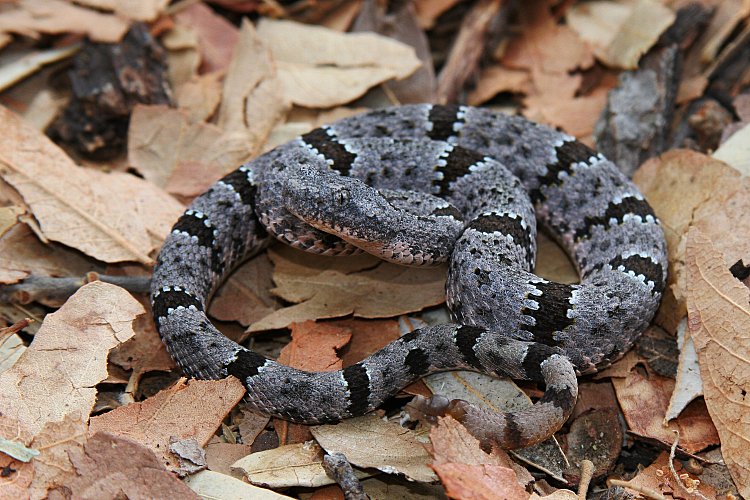
A young Banded Rock Rattlesnake (Crotalus lepidus klauberi).
Very nice. Another look:
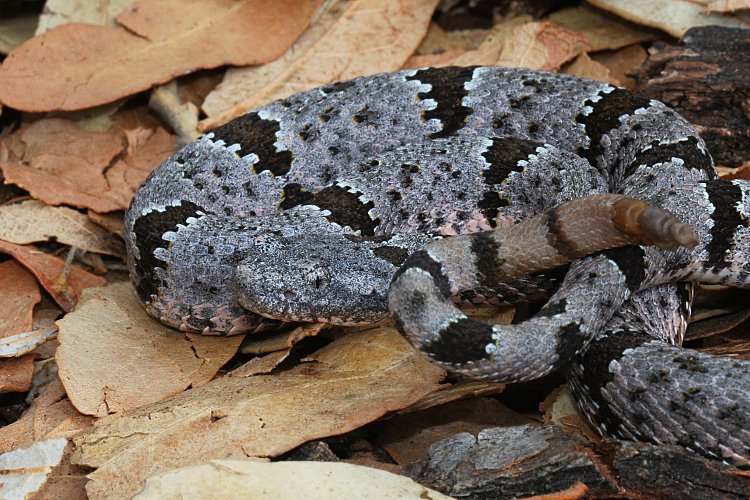
An excellent "first snake" for the trip!
A little while later, we spotted this young fellow:
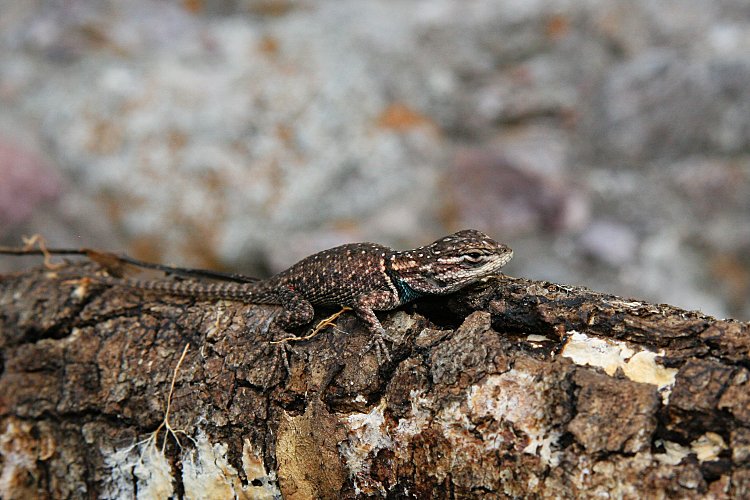
Yarrow's Spiny Lizard. We wound up seeing several more of these.
Somewhat later while I was walking down a dry creek bed I spotted
a Ridgenosed Rattlesnake! Initially it was stretched out on some
gravel; had it been leaves it would have been much harder to see.
One of those rare moments you spot what you're looking for!
Here it is:
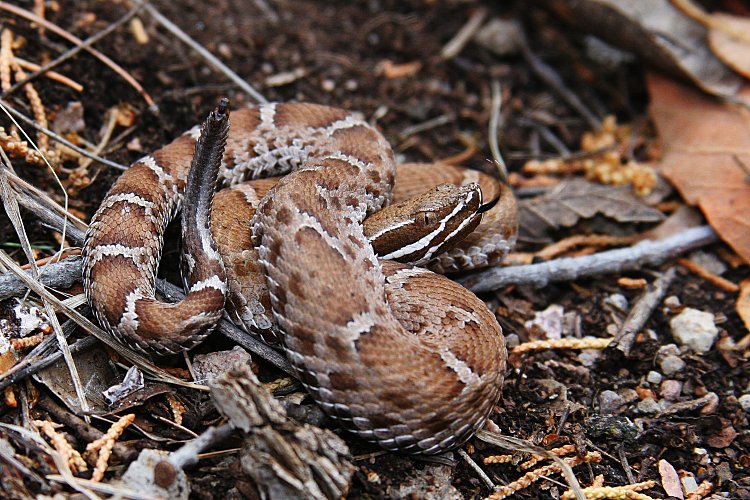
Arizona Ridgenosed Rattlesnake (Crotalus willardi willardi).
Here's another look:
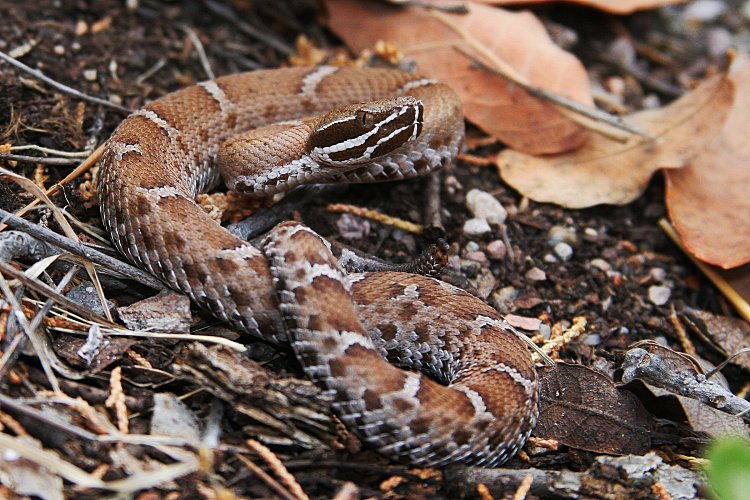
And another:
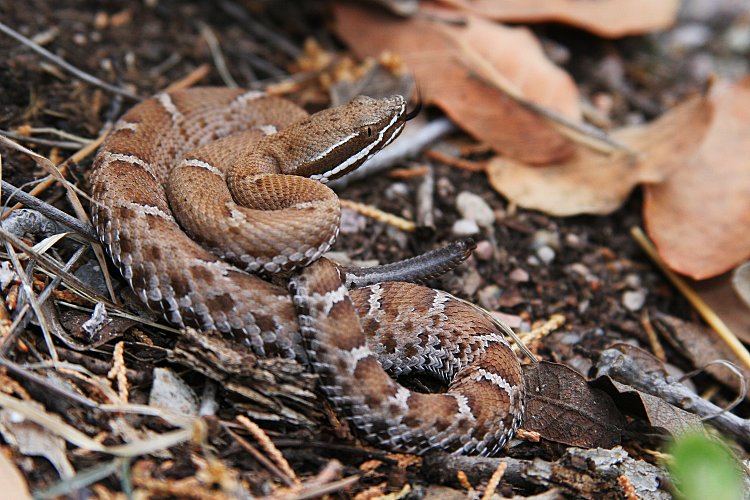
And a shot of the snake with its habitat:
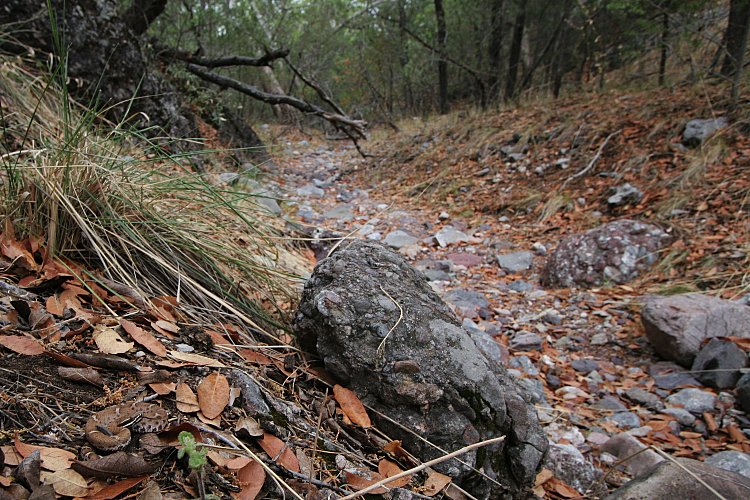
There were many aspects of this snake which reminded me of the copperhead:
its color, its demeanor, and its style of coiling.
We hiked around some more but didn't see anything else.
I couldn't believe that we'd only been here one day, had only seen
two snakes, but they were two of our most wanted!
The rainfall and cloud cover were most definitely a fortuitous development.
Here's a photo of Jason and Young at the end of the day:
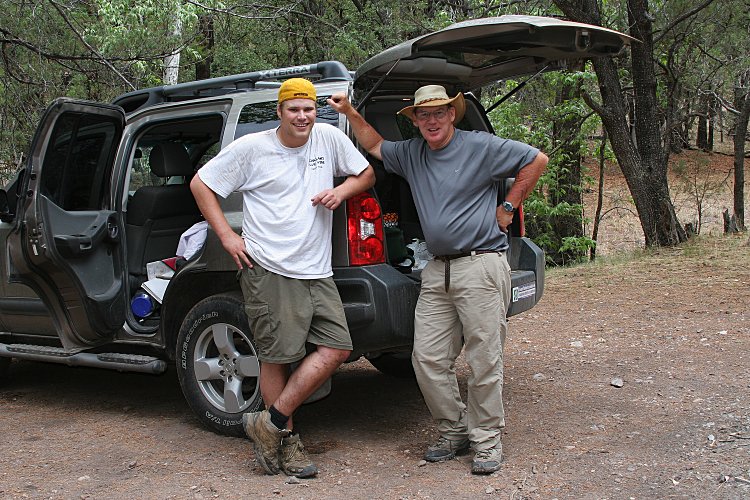
Young was great company and has a vast knowledge of the area's herps.
He gave us some suggestions for the rest of our trip and parted ways.
Thanks, Young.
On the way out we got a flat tire -- perhaps the herp gods reminding us that things don't always come easy. To further that theme, that evening and night we tried road cruising in a new area but had absolutely no luck.
We camped at the trailhead for the next morning's hike. We woke up
early and headed out, hoping that the early, cool weather would work
in our favor. We saw several whiptails, which we believe were
Desert Grassland Whiptails (Aspidoscelis uniparens), but
we were unable to capture or photograph them.
We did see this out on the crawl early in the morning:
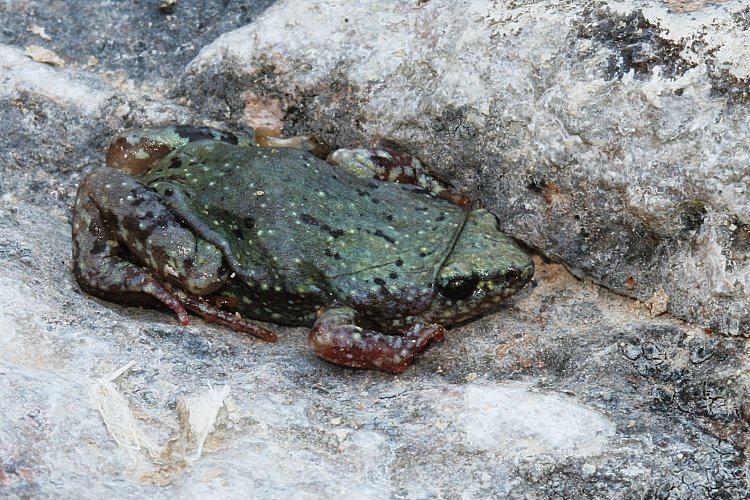
Great Plains Narrow-mouthed Toad (Gastrophryne olivacea).
Later we also saw a Canyon Treefrog hopping out around out in the
heat of the day. It escaped into a deep crevice while we were fooling
around with our camera gear... Rather odd that we were seeing
amphibians out on the crawl in the middle of this dry spell.
At one point while I was walking down the trail, there was a whiptail
that was leading the way in front of me, always keeping a distance
of about 10 feet or so ahead of me. This must have gone on for
fifty feet or so. If you've ever spent much time around whiptails,
this is not an unusual thing for them to do. At some point I
mentioned to Jason that I had a whiptail over here -- not very
exciting news since we'd see plenty, just hadn't gotten close to them.
He looked back at me with this sort of blank look on his face.
I was watching the whiptail, but he just kept staring at me.
Well, after some conversation along the lines of "Who's on First"
I finally figured out that there was Vinesnake (!!!!) stretched
out across the trail about one foot in front of me, with its
head sticking up looking at me...
Here's an in situ photo of the situation which Jason took:
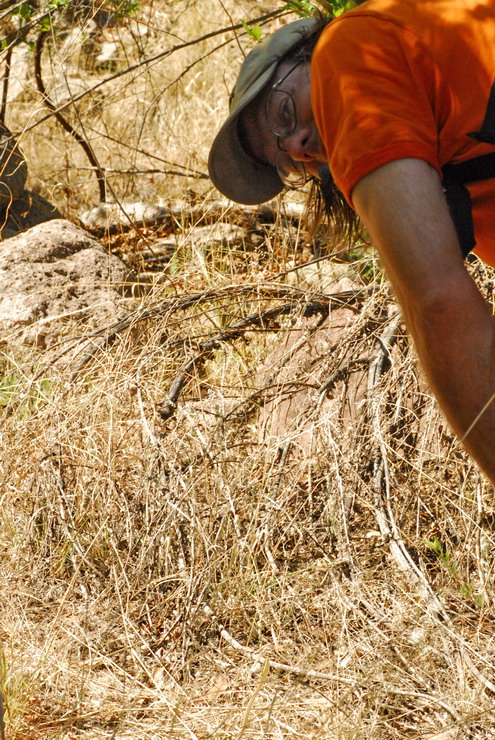
If you look carefully at the bottom of the pic you can see the snake's
head pointing almost straight up. Unfortunately you can't see the
big grin on my face. I am certain the snake was not there when
the whiptail ran up the trail about 20 seconds earlier.
Perhaps it was drawn out of the grass by the passing whiptail?
In any case we had found ourselves a Vinesnake (!!!!):
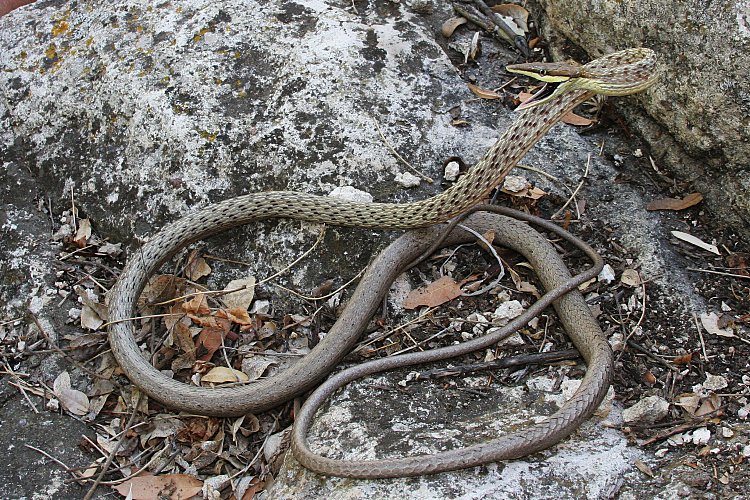
Brown Vinesnake (Oxybelis aeneus).
Money shot:
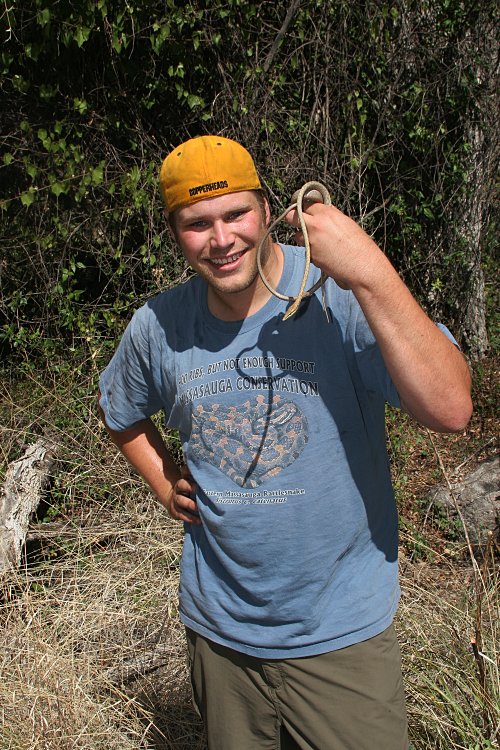
Side view:
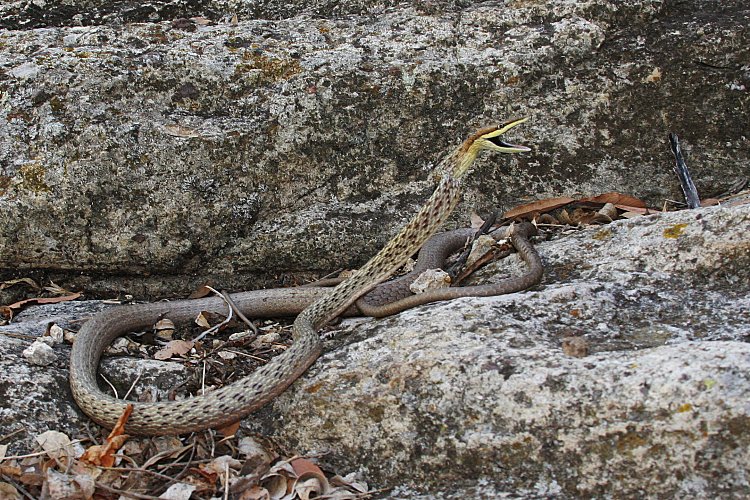
Comin' at ya:
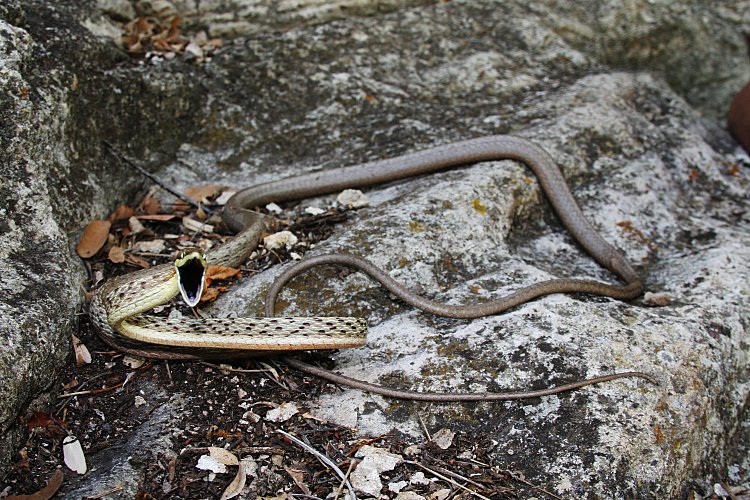
I'd say they act tougher than they are, although it's
not all bluff. Close up:
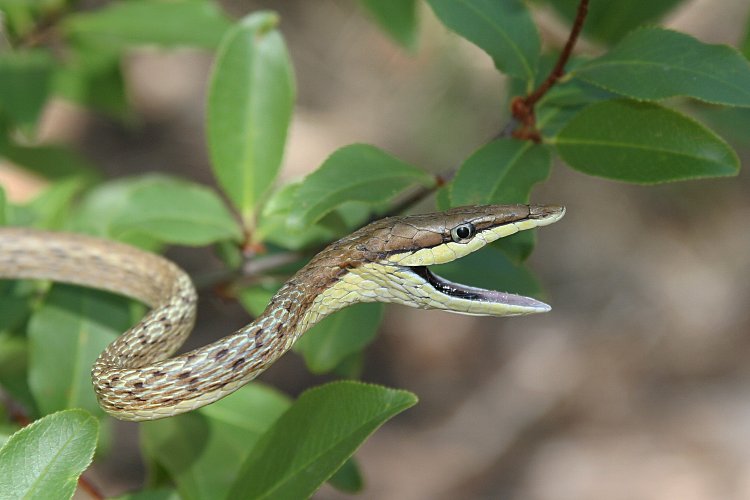
Notice how it's neck is not expanded now, compared to some
of the above shots. Another head-on shot:
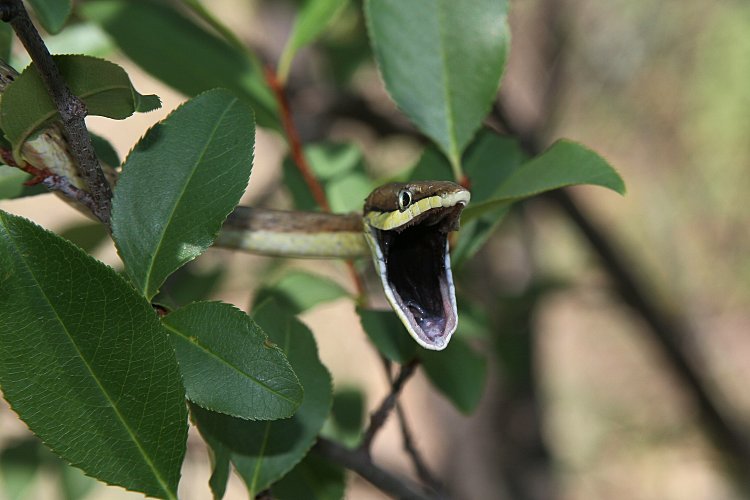
One last look:
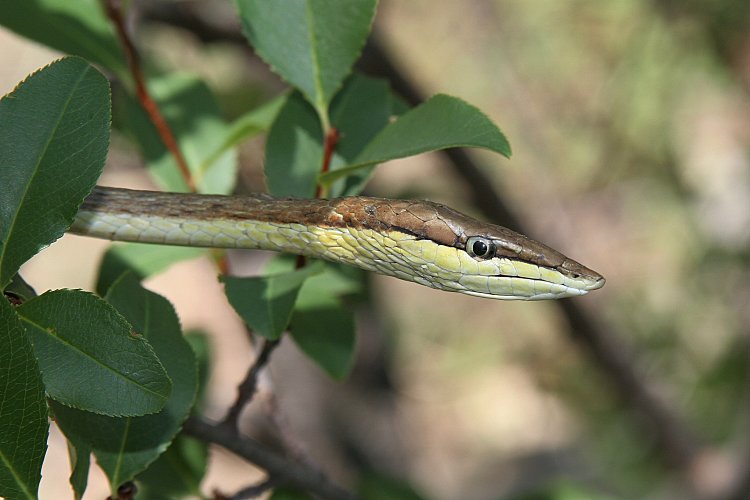
This snake just about refused to shut its mouth, this is
nearly the only pic I got with its mouth closed.
It was really neat seeing these snakes in person.
My preconceived notion was that they would have the speed
and attitude of Coluber or Masticophis,
but that proved to not be the case. This animal, at least,
was considerably more deliberate.
Here's the habitat near where the Vinesnake was found:
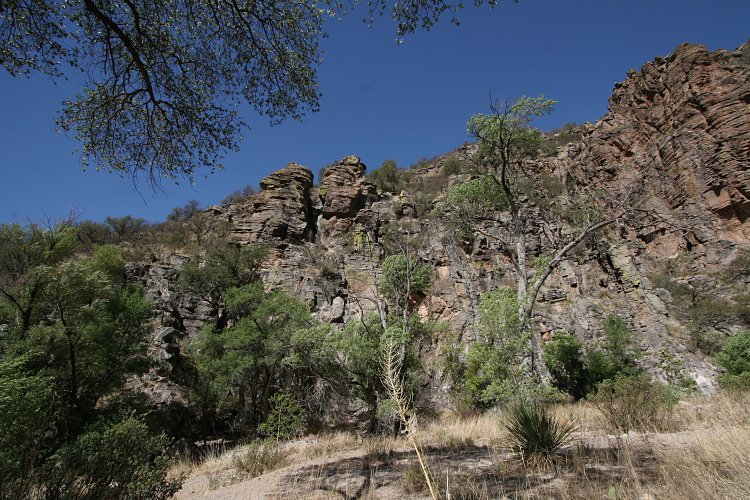
Here's some other herps we saw on the hike:
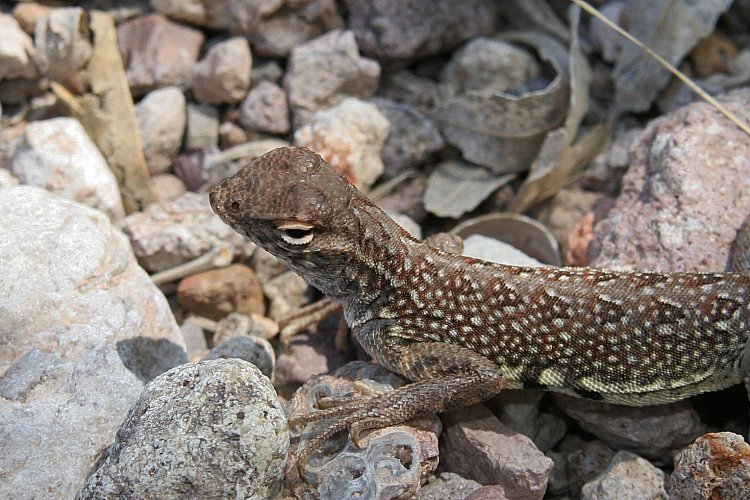
Lesser Earless Lizard. Apparently the flavor present down here
is different from that in most of the rest the U.S. and
is now considered a different species, Holbrookia elegans.
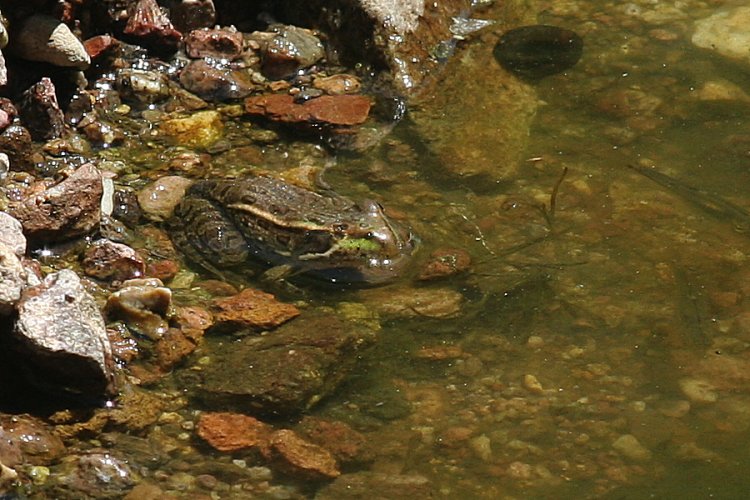
Chiricahua Leopard Frog (Rana chiricahuensis). Something seemed
to be wrong with its right eye, but we weren't able to get any closer.
We also saw Clark's Spinies in the area, but couldn't get close enough for pics. This species is one I'd really hoped to get a decent photo of.
We packed up and headed off to our next destination.
Here's some scenery:
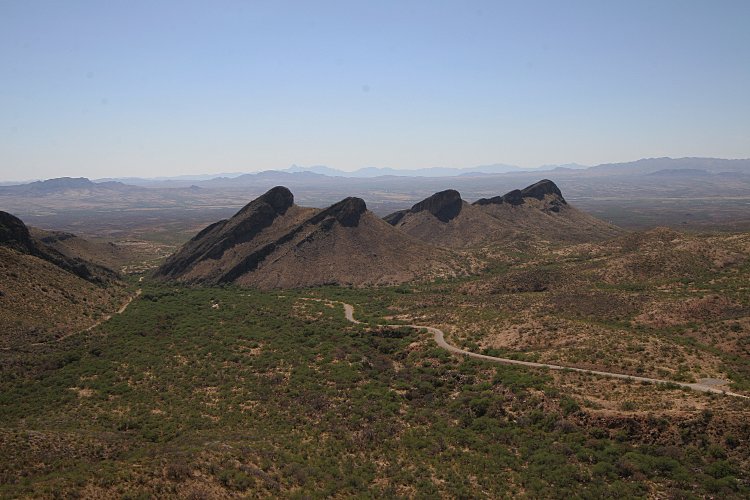
We would cruise the road below later that evening.
Here's another view, from further up:
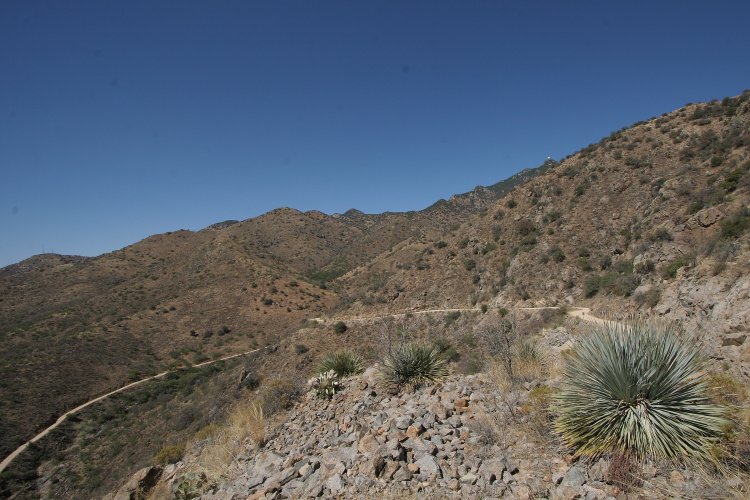
We headed off to another canyon and took
a long hike through some beautiful habitat.
We saw Yarrow's spinies and one Clark's; that was it.
We ate dinner and started cruising. Right as it was getting completely
dark, we found a Lyre Snake on the road. We bagged this one, hoping
to be able to take some decent photos in the morning.
Our campsite was close by, so this was a convenient option.
A few minutes later we found another Lyre on the road.
Here's a quick attempt at photographing it on the side of the road:
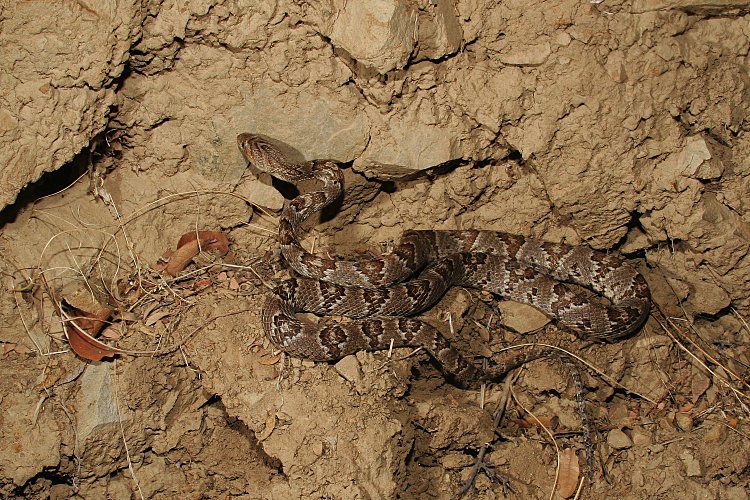
It didn't want to cooperate for photos and we were eager to
get back on the road since it seemed that snakes were moving...
We cruised for quite a while without seeing anything except
for a DOR Regal Horned Lizard.
Then at one point we saw this up ahead:
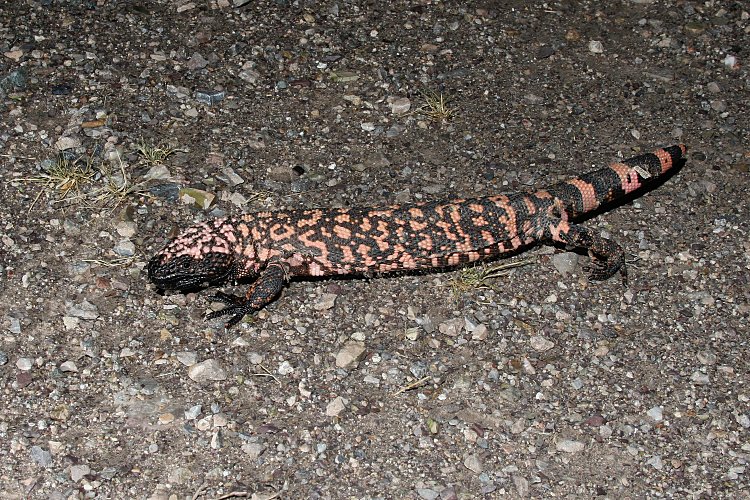
A Gila Monster! Another look:
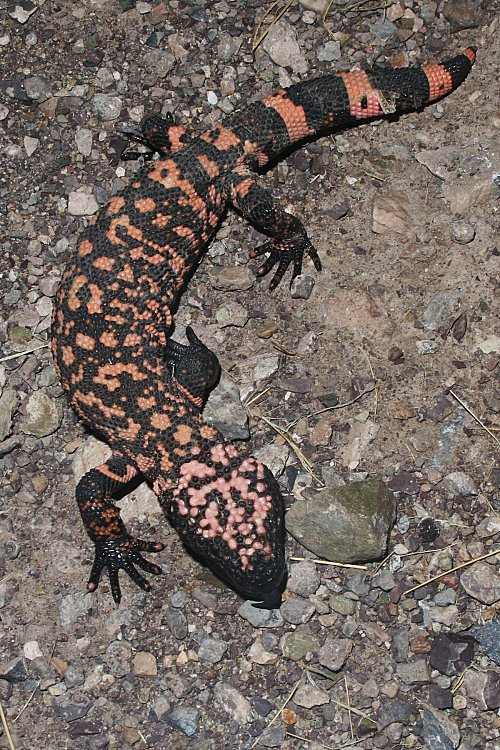
It wasn't very interested in sitting still for photos...
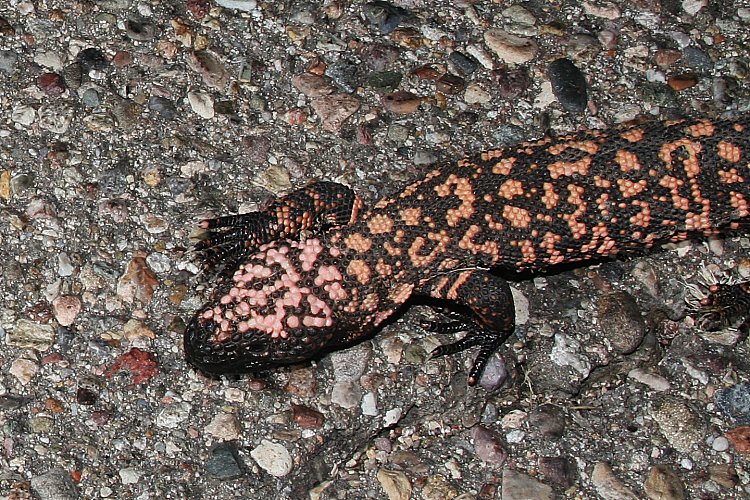
The Gila was one of the species we had hoped to see -- and we
felt most fortunate to have found one. We cruised quite a bit
more but didn't see anything else.
After a good night's sleep, we packed up and were preparing to
take some photos of the Lyre we had caught the previous night.
Then Jason spotted a young black bear ambling towards our campsite:
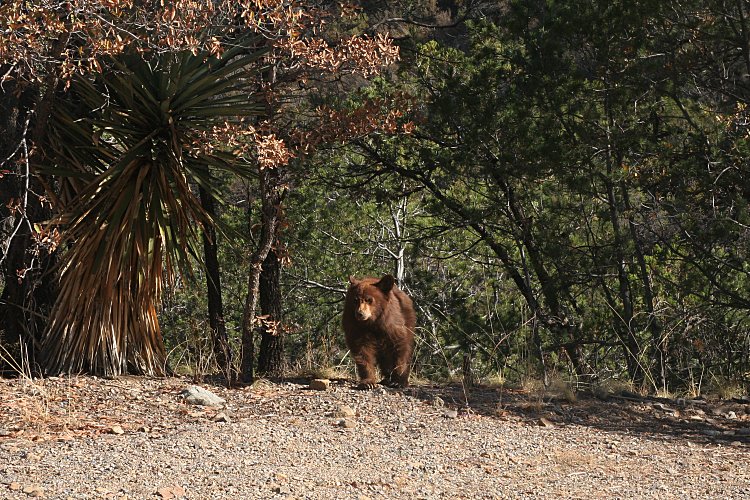
It came over and hung out in the crotch of a tree:
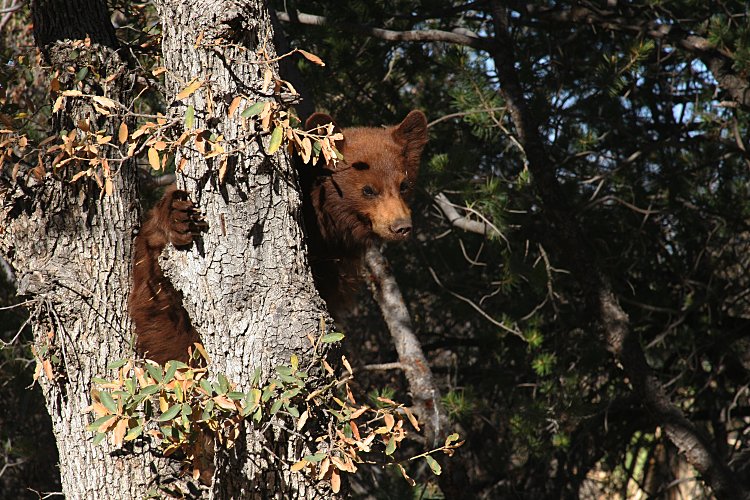
At first we thought this was great -- what a wonderful opportunity to
get some bear pics -- and something which we obviously took advantage of.
We were as close as one would ever want to be to a wild bear.
If you're wondering about safety, we were right next to the vehicle.
After a while though, we'd had enough of the bear. We had other
things to do, and a Lyre to photograph. The bear couldn't be shooed away.
Even honking the car horn from 20 feet away wouldn't get it to budge.
So we gave up and drove off on our way. We speculate that this young
bear must have been very hungry or thirsty (conditions were very dry).
So a little ways down the road we stopped to photograph the Lyre:
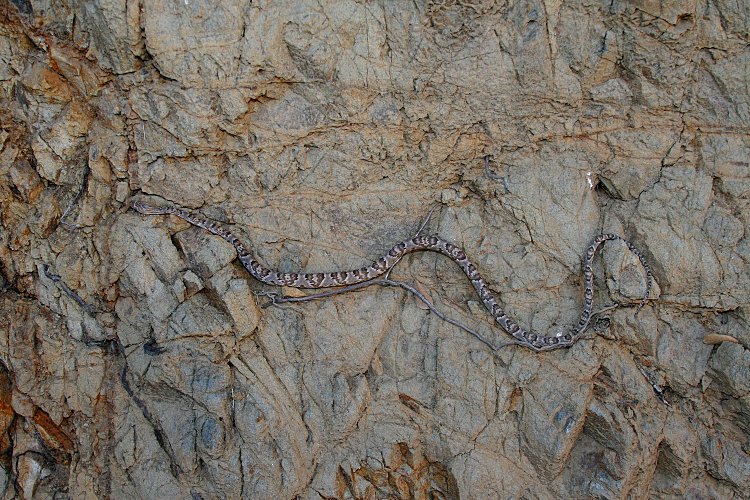
Very at home on a rock cut.
This one didn't have much interest in posing for photos either... so I
settled for some head portrait shots:
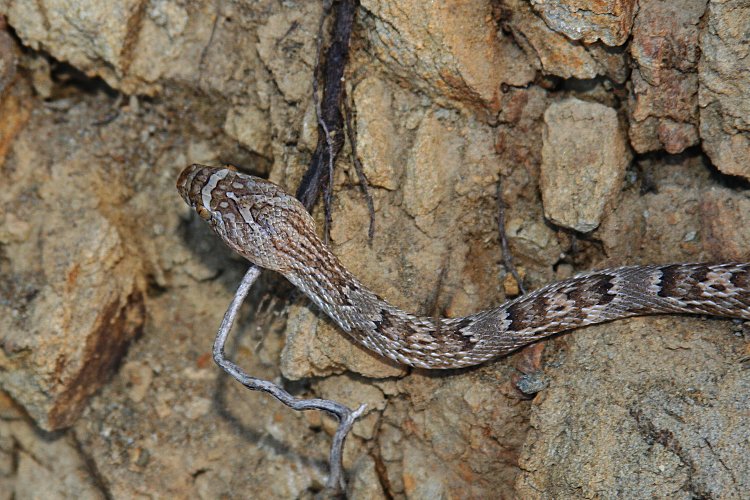
Top view:
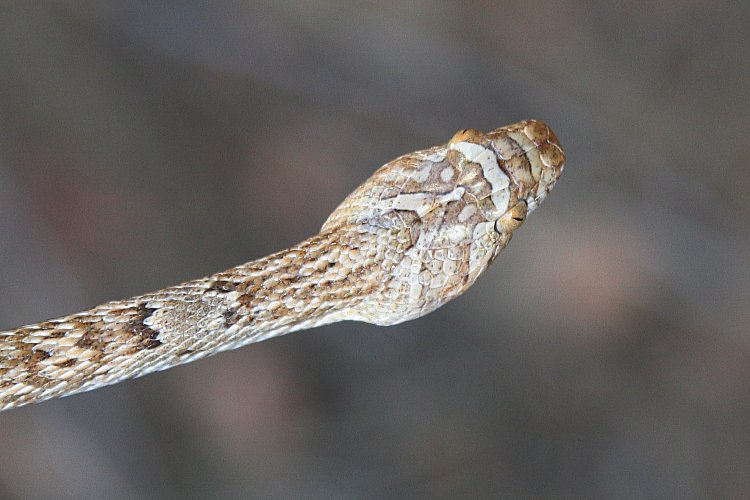
Side view:
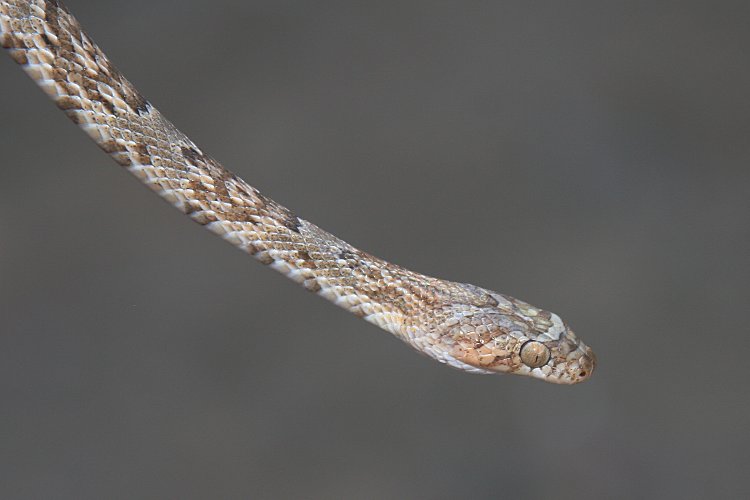
We released the Lyre where we found it and headed off on our way.
Down in the valley below we came across an interesting DOR
which appeared to have been killed earlier in the morning:
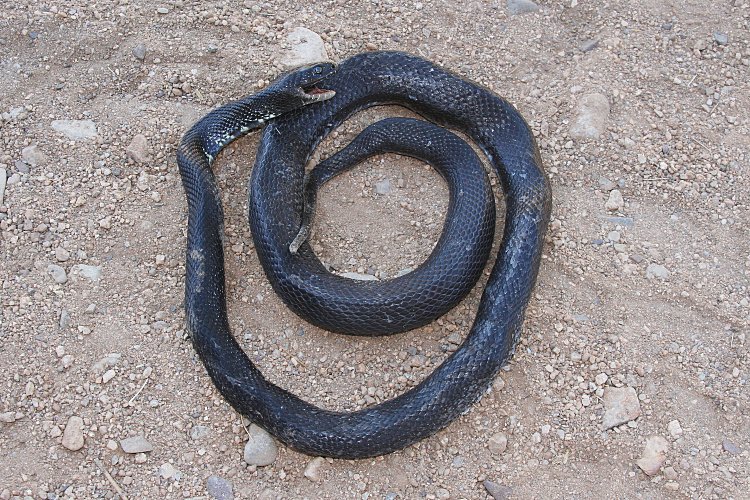
An all-back kingsnake (Lampropeltis getula).
It goes without saying that that this would have been a great snake
to see alive.
We stopped and looked around some desert habitat at lower elevation. We saw Cophosaurus texanus, Holbrookia elegans, and Aspidoscelis tigris, but none were photographed.
We returned to the same range we had explored two days before,
but this time we investigated some different canyons.
Considerable hiking yielded several Yarrow's Spinies:
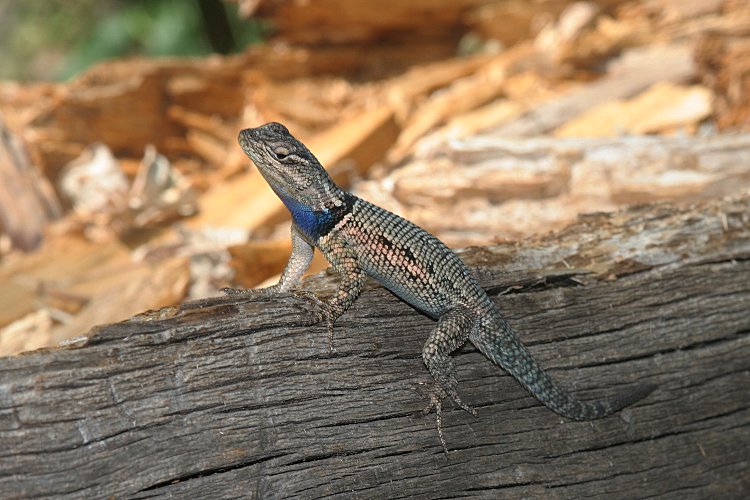
Another one:
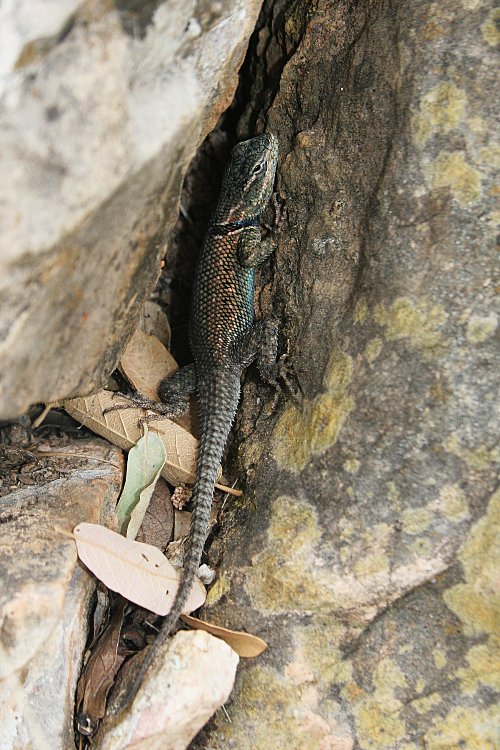
And another:
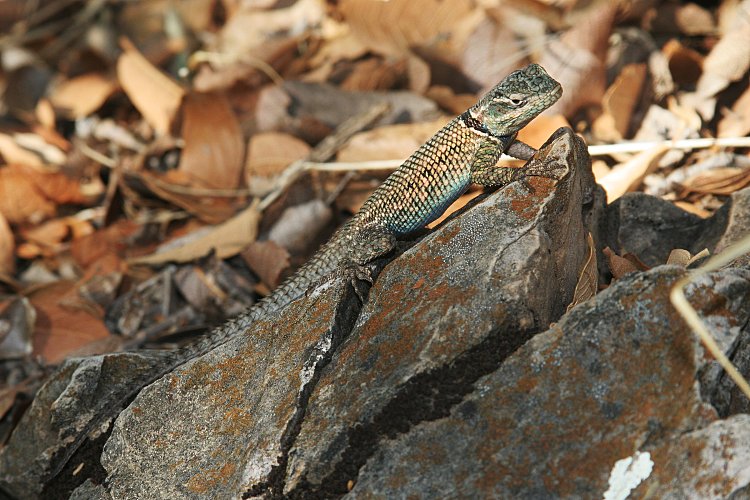
I really enjoyed seeing these lizards; they are not too shy,
and are quite pretty. One of the signature herps of the Sky Islands,
for sure.
We also saw two Madrean Alligator Lizards (Elgaria kingii),
but we were unable to photograph either one.
Road cruising that night we found this:
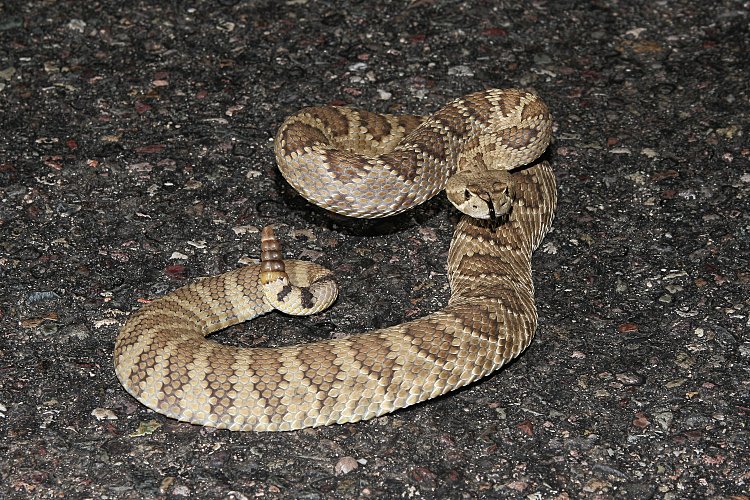
Mojave Rattlesnake (Crotatlus scutulatus).
Another look:
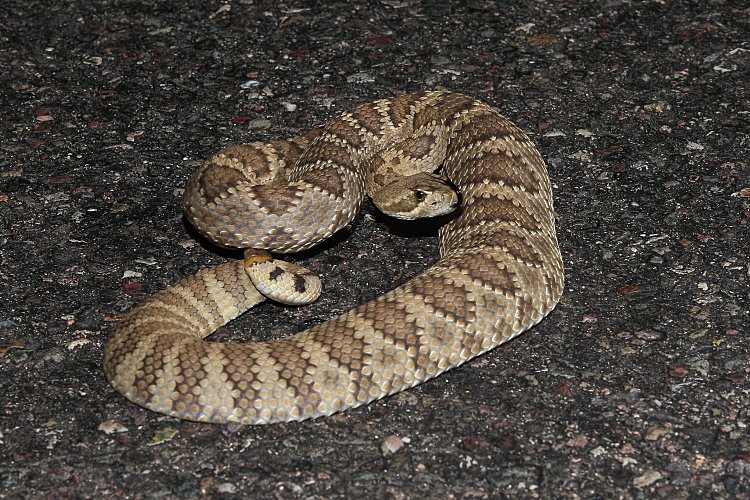
We also saw another Mojave that had been hit and a DOR gopher snake.
The next morning we woke up and headed high up into the mountains
with hopes of seeing another species of montane rattlesnake.
It took some looking but we were successful:
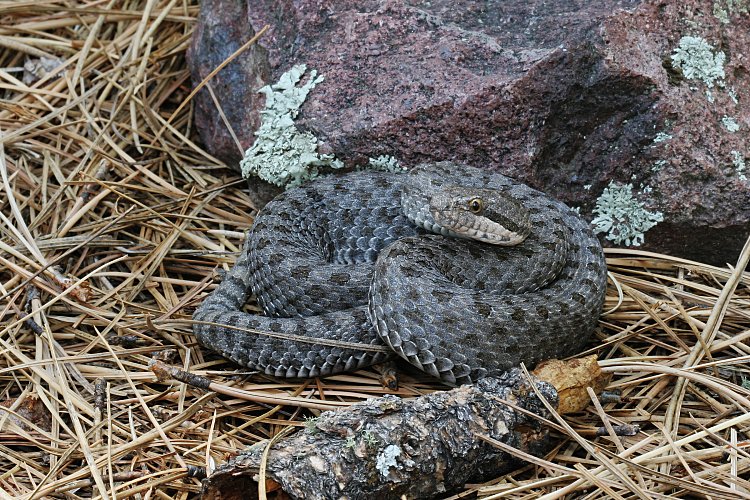
Twin-Spotted Rattlesnake (Crotatlus pricei).
Two were found; this is the smaller one. Props to Jason for finding them!
Here's the larger one:
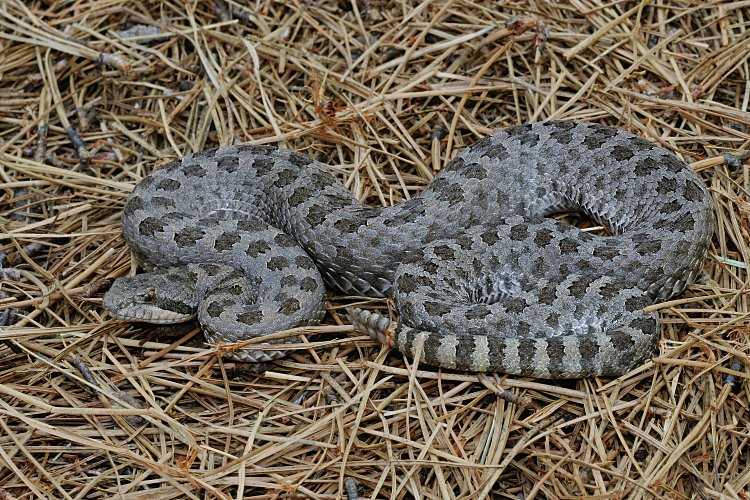
Closer look:
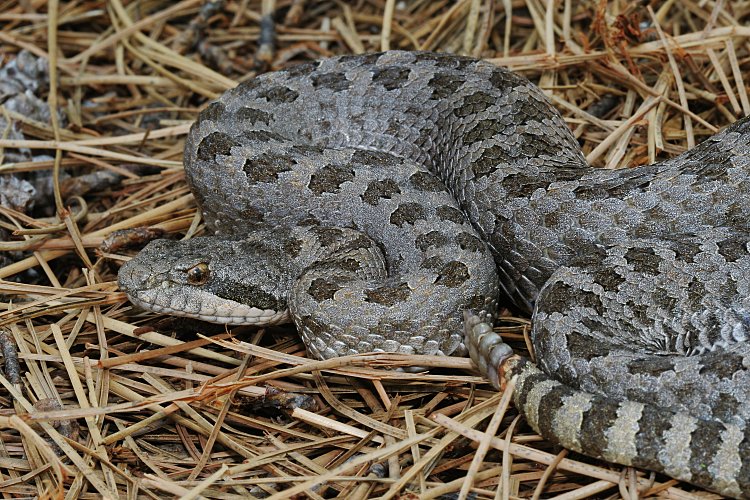
I was both excited and surprised that we were able to complete the
montane rattlesnake trifecta on this trip.
Here's some interesting talus-slide habitat not too far from where
the pricei were found.
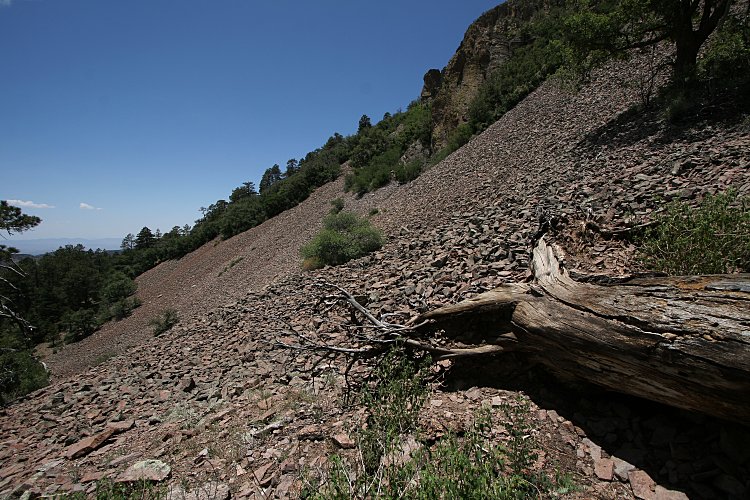
On this day, exposed areas such as this were probably too hot
for much snake activity. The pricei were found in a much
more shaded area, with just a bit of dappled sunlight getting through.
We looked around some more but the only other herps seen were
Yarrow's Spinies.
A nice mountain vista:
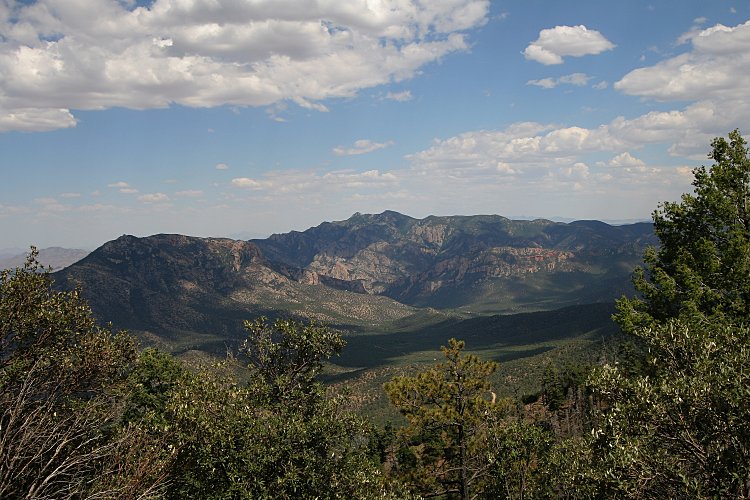
We moved on to another canyon and tried our luck.
Yarrow's Spinies were out in force:
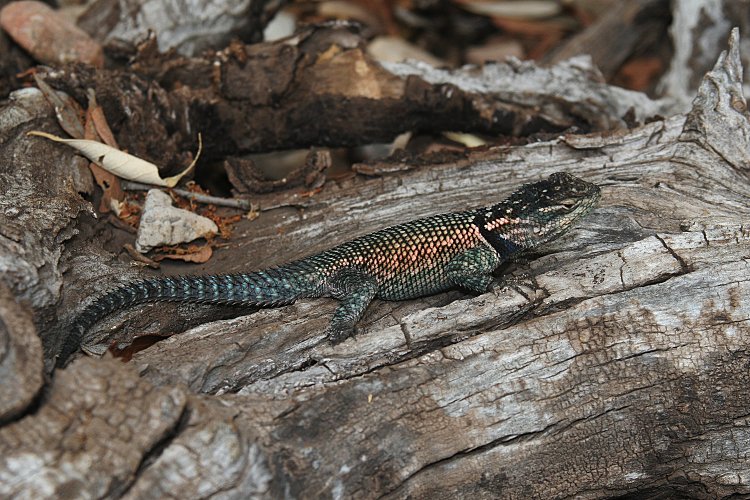
This one was particularly colorful so I took a few photos...
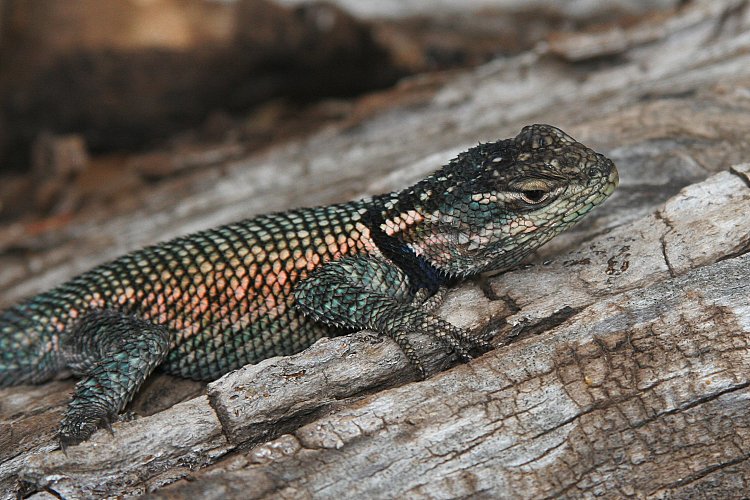
Another angle:
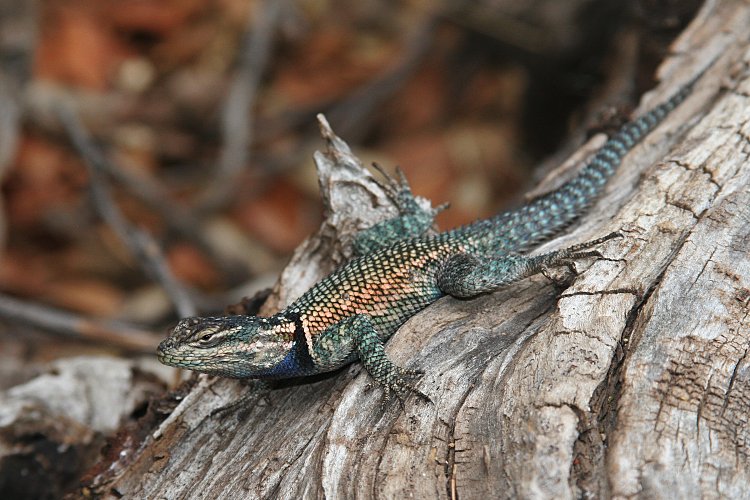
Another spiny lizard species was seen at this locality:
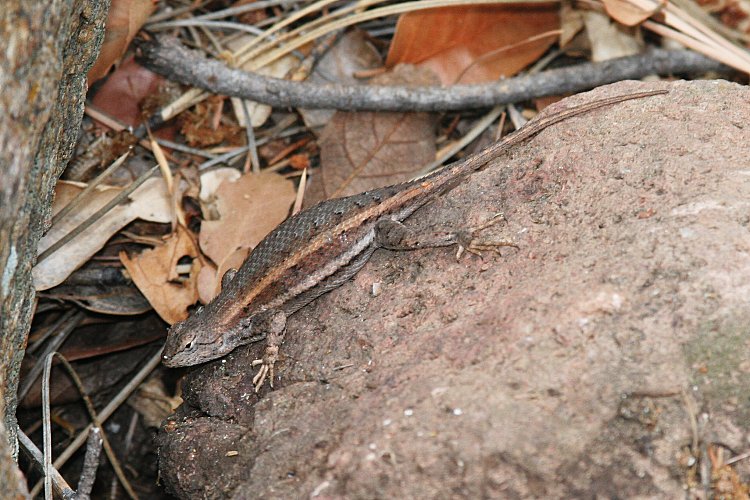
Striped Plateau Lizard (Sceloporus virgatus). Another one:
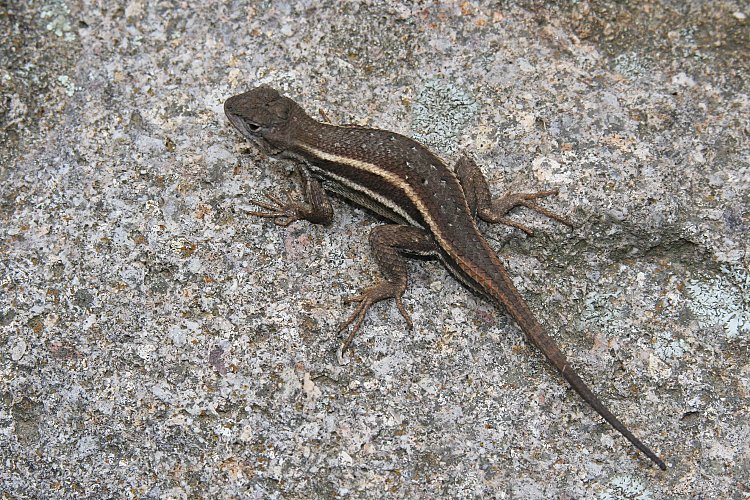
No additional snakes were seen, although we did find two
lepidus sheds.
Here's some animals we saw road cruising that night:
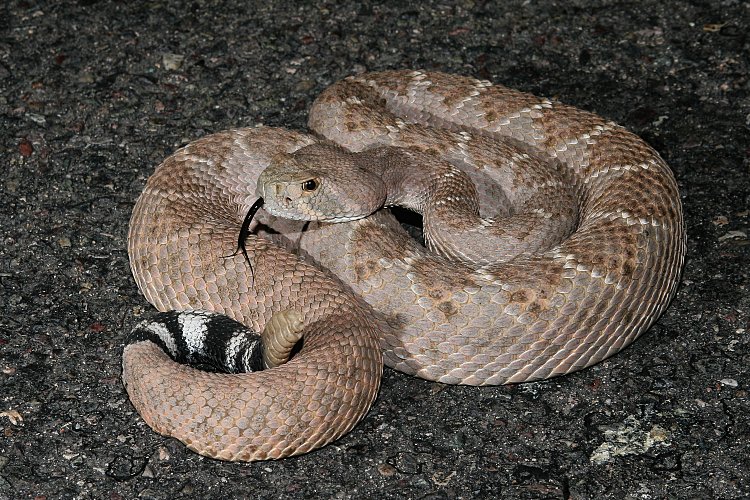
Western Diamondback Rattlesnake (Crotatlus atrox).
A good sized one with a nice pink color.
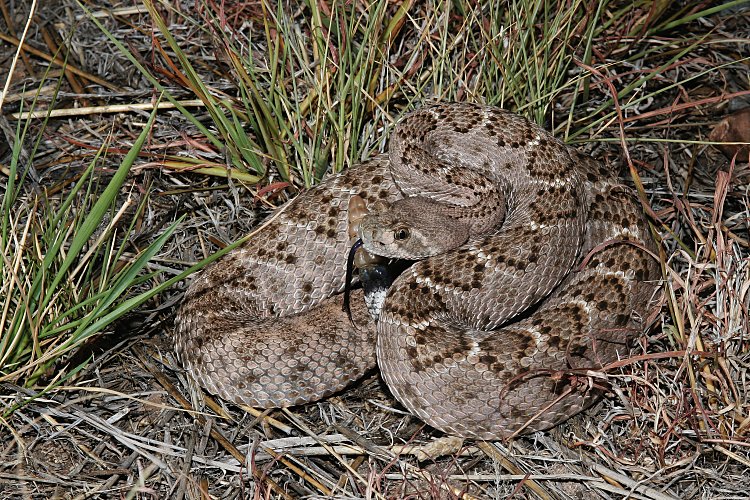
Another Western Diamondback.
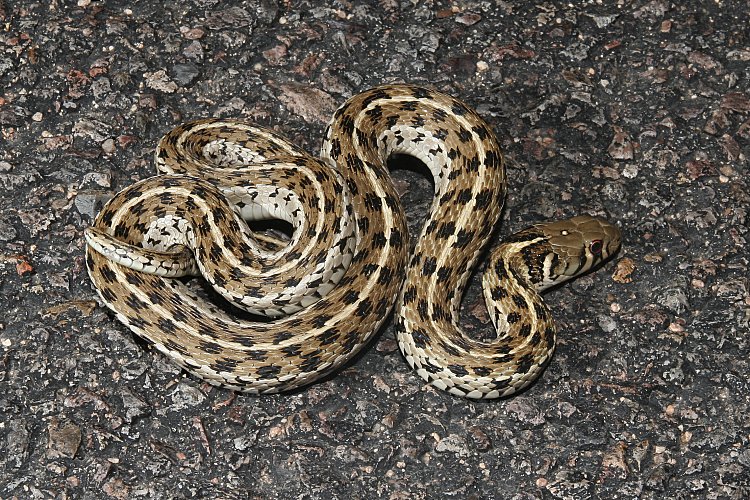
Checkered Gartersnake (Thamnophis marcianus).
Pretty lousy photo, but hey, it wouldn't sit still and we didn't want to
spend all night fooling around with it.
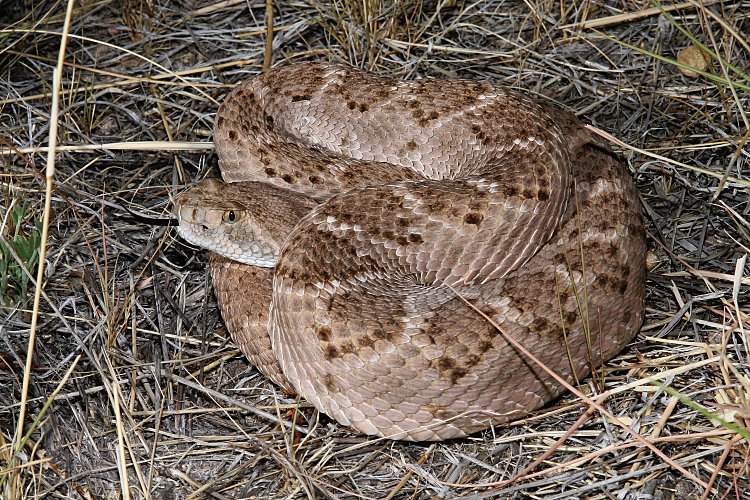
Another Western Diamondback.
We also saw a couple more mojaves that night.
The next day we reluctantly packed up one last time and head off to the airport. We were both pretty tired, having herped pretty much non-stop for five nights and four days straight. By my count we saw a total of 16 live snakes. That's not a large number, but the quality and diversity is excellent. Surprisingly, we missed a number of the more common species of snakes such as Masticophis. We did pretty well on lizards too, although I'm a little disappointed that I didn't get pics of a Madrean Alligator Lizard or Clark's Spiny. Conditions for amphibians were lousy and we felt very lucky to see as many as we did. There are in fact plenty of things that we didn't see which I'm sure will draw us back for a next time. I would put the Blacktailed Rattlesnake and the Sonoran Mountain Kingsnake on that list as well.